#orinoco basin
Explore tagged Tumblr posts
Note
Have you done the hoatzin yet? My all time favorite bird 💕
Not yet! Good choice! For those who don't know, these unique birds mostly eat leaves (rare in birds!) and their young have primitive claws. They have been the subject of a lot of scientific attention!
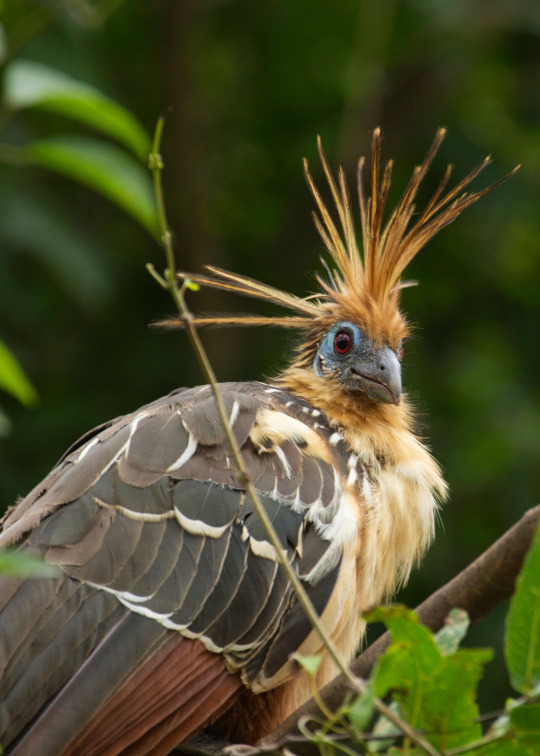
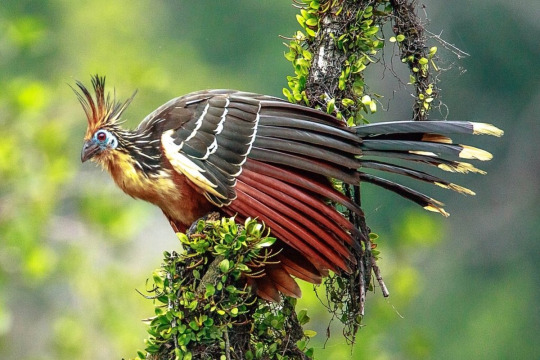
#south american bird#south american birds#hoatzin#Canje pheasant#amazon rainforest#orinoco basin#bird#birds#ornithology#animal polls#poll blog#my polls#animals#polls#tumblr polls
130 notes
·
View notes
Text


Orinoco Matamata (Chelus orinocensis), family Chelidae, found in northern South America in the Orinoco, upper Rio Negro–Branco and Essequibo basins, and in Trinidad.
First described as a distinct species in 2020.
photographs: Vargas-Ramirez et al., RatioTile
#matamata#mata mata#turtle#chelus#chelidae#reptile#herpetology#side neck turtle#animals#nature#south america
324 notes
·
View notes
Text
The Cryptic Crocs of the Caribbean
I have been positively swamped with work and other responsibilities and of course that's just when theres a lot of really interesting papers coming out. The subject of this particular post is something a little more recent than my usual focus, by which I mean it concerns crocodiles very much alive right now.
In "Novel island species elucidate a species complex of Neotropical crocodiles", author Jose Avila-Cervantes and colleagues present a large scale project attempting to establish a more robust history of neotropic crocodiles by taking a closer look at species and population divergences, specifically through genomic and phenotypic data.
Part of the stated goal was to try and shine a closer light on the relationships among the neotropic species of Crocodylus (consisting of Morelet's crocodile, the American crocodile, Orinoco crocodile and Cuban crocodile), who's phylogeny remains somewhat poorly known. One of the complicating features is the poor fossil record. I've mentioned it before, but as it is currently understood, the oldest neotropic crocodile is C. falconensis from the Pliocene of Venezuela, which sits outside the modern species and might be most closely related to the Miocene C. checchiai from northern Africa, by extension establishing a link to today's African species. Beyond that tho the American fossil record is poor, with fossils typically only identifyable to the genus level (not counting some island localities preserving the remains of Cuban crocodiles). The second complicating feature is the fact that neotropic crocodiles seem to be quite fond of interbreeding, with hybrid populations between American and Morelet's crocodiles present along the Yucatan Peninsula and possible hybrids between Cubans and Americans on, well, Cuba.
The four classically recognized species of the neotropics, the large American crocodile (Jose's crocodile river tour, top left), the agressive Cuban crocodile (Steve Cooper, top right), the humble Morelet's crocodole (yours truly, bottom left) and the slender-snouted Orinoco crocodile (Phoebe Griffith, bottom right)




Particular focus of the study is the American crocodile (Crocodylus acutus), given that it is without a doubt the most wide ranging of today's neotropic crocodiles. This species ranges from the Mexican Pacific coast to Florida and south to northermost Peru and Venezuela as well as a huge swath of the Caribbean, inhabiting both inland freshwater biomes as well as mangroves, islands and everything in between.
The current range of the American crocodile (Crocodylus acutus) via Data Basin
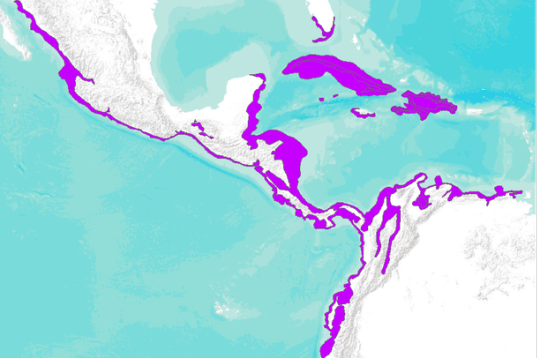
However, as a consequence the paper has found that there is quite a lot of genetic variation within this species, especially among the populations of the Mexican Pacific Coast and island populations. Now in terms of morphology it is noted that the range of American crocodiles is quite wide, with the phenotypes of island and mainland species overlapping. However it is also noted that there is only minimal overlap between the island forms themselves.
Especially distinct are two populations found south-east of Yucatan, namely those of Cozumel island and the atoll of Banco Chinchorro. Phylogenetic trees actually suggest that these two form their own branch among American crocodiles that is positioned as the sister clade to all other populations. The two populations are noted for their surprisingly diverse genetic pool, no signs of admixture with other populations and an estimated population size of about 500 individuals each (as is highlighted by the study, this is about 10 times more than previously thought).
A crocodile in the waters around Banco Chinchorro by javie.33

As a consequence, the team supports the not-that-new idea that Crocodylus acutus is a species complex rather than a single well separated species, with the Banco Chinchorro and Cozumel populations judged to be distinct enough to warrant being given their own species names. Now the team has refrained from coining those (so far), but at least suggests naming them after their home islands. If this comes to pass and is widely accepted, then this would essentially make the two "cryptic" species, something thats happend before in crocodile research. Just to give a concrete example, similar things have previously happened with the split between Nile and Sacred crocodile (C. niloticus and C. suchus) as well as the two New Guinea crocodiles (C. novaguinea and C. halli). Furthermore, the fact that these two are distinct opens up the possibility that other populations could likewise be a lot more different than previously thought once enough genetic data is collected. One such population not given much attention in this study would be the "hybrid" population on Cuba, which the paper off handedly suggests could also represent a cryptic species.
To take a brief detour, the paper does spend some time highlighting some of the stuff that makes the Chinchorro species so distinct. Physically, they differ from their Cozumel relatives by having longer and broader skulls and subtle differences in their armor. Even their ecology is different, appearing to consume more hard-shelled prey.
Compared to other populations in general, they seem to produce smaller and fewer eggs than other populations, something that could have to do with the high salt content of the local waters. Their entire growth rate appears to be lower, taking longer to reach the same size as their relatives and females become sexually mature at a smaller size. Despite all of this however, they are doing quite well for themselves with a respectable success rate aided by the lack of predators. Following the research done on the population, the main threats to hatchlings seem to be heavy rainfall and tropical storms. What's even more interesting however is the relationship between the Banco Chinchorro crocodiles and the salinity of their surrounding environment. As is known, true crocodiles of the genus Crocodylus may have different habitat preferences, but as a whole they are quite capable of dealing with saltwater, having allowed their dispersal across much of the planet. Now the paper mentions that though prefering freshwater, Morelet's crocodiles can tolerate a salinity of up to 22 ppt (parts per thousand) while the typical American crocodile inhabits environments with a salinity of around 34 ppt. Now get this. The salinity at the Banco Chinchorro atoll ranges from 30 to 65 ppt with an average of 52.9 ppt, the highest salinity tolerated by a member of this genus.
Like the famed saltwater crocodile, American crocodiles are well known for entering saltwater.
As a final point, the study goes on to highlight the positive aspects that coining two new species could have. While populations would obviously be quite small and both islands face similar dangers, they suggest that this could be a great opportunity to use the Cozumel and Banco Chinchorro species as umbrella or flagship species to promote not only the protection of the crocodiles but also of all the other animals that inhabit this part of the world as well as their habitats as a whole. To this extent, its good to hear that while Cozumel is a partially urbanized tourist destination, some of its most important crocodile populations inhabit protected areas while all of Banco Chinchorro is a Biosphere Reserve.
Left: Naturally a major threat to these animals is habitat destruction and conflict with humans, as one can imagine might arise given their proximity to tourist beaches as recorded by Iliana Acosta Right: Over at the protected Banco Chichorro meanwhile it seems that you can actually dive with crocodiles. (Photo by Oceanographic Magazine)


As a final note I just want to say that I'm very excited to see these two animals described in proper and what other cryptic crocodiles might be found elsewhere. And of course I hope that they get the protection they need so that they are preserved for future generations.
#american crocodile#crocodylus acutus#neotropic crocodile#croc#crocodilidae#crocodile#crocodilia#herpetology#reptile#mexico#new species
57 notes
·
View notes
Text

Caño Cristales River, Colombia: Caño Cristales is a Colombian river located in the Serranía de la Macarena, an isolated mountain range in the Meta Department. It is a tributary of the Guayabero River, itself a part of the Orinoco basin. Caño Cristales was found in 1969 by a group of cattle farmers. Wikipedia
#Caño Cristales#Caño Cristales River#Crystal Channel#Serranía de la Macarena#Meta Department#Colombia#south america#south american continent
88 notes
·
View notes
Text
Daily Ray Fact:
The Ocellate River Ray, also known as the peacock-eye stingray or black river stingray, is a species of freshwater stingray. It is the most widespread, ranging throughout much of the Río de la Plata, Amazon, Mearim and Orinoco basins in tropical and subtropical South America.
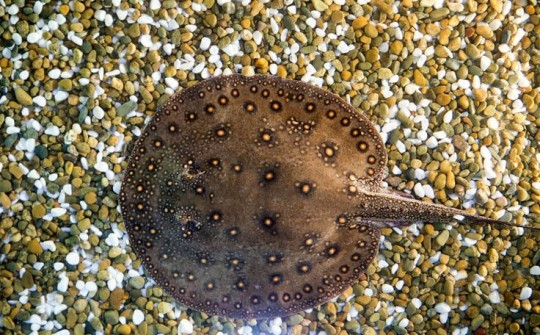
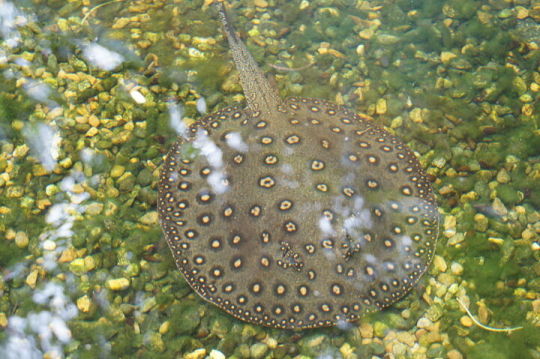
#ocellate river ray#river stingray#stingray#daily ray facts#ray facts#ray family#respect the locals#cartilaginous fish#fish#stingray post#shark blog#freshwater ray#freshwater fish#freshwater#stingrays#marine life#animals
108 notes
·
View notes
Text
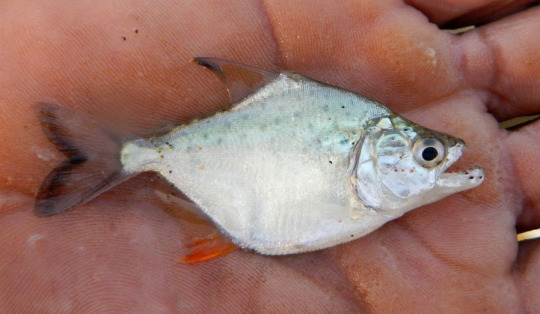
Wimple Piranha (Catoprion mento)
Family: Serrasalmid Family (Serrasalmidae)
IUCN Conservation Status: Least Concern
A tiny (15cm/5.9 inches in length) relative of the more famous Red-Bellied Piranha, the Wimple Piranha is found in the Amazon, Orinoco, Paraguay and Essequibo river basins, and is notable for its unusual diet; adults of this species feed almost exclusively on fish scales, feeding by ramming into larger fish at high speeds with their mouths wide open, biting and generating suction to dislodge their target’s scales and pull them into their mouths. The practice of eating scales, known as lepidophagy, is rare in animals as scales are difficult to digest and require considerable amounts of energy to obtain, and it is likely that it developed in response to the intense competition between fish species in the biodiverse rivers to which Wimple Piranhas are native - although their nutrients-poor diet limits their size, feeding exclusively on scales (occasionally supplemented by small insects or small amounts of the meat of their otherwise unharmed targets where possible) allows Wimple Piranhas to find food while largely avoiding competing with larger and less specialised carnivores. Besides their unusual feeding habits little is known about the biology of wild Wimple Piranhas, although through the observation of captive individuals it has been found that unlike many piranha species they are solitary (possibly avoiding living in groups to avoid competing with other members of their species,) and that like other members of their family females of this species lay eggs.
--------------------------------------------------------------------------
Image Source: https://www.inaturalist.org/taxa/342485-Catoprion-mento
#Wimple Piranha#piranha#piranhas#fish#fishes#zoology#biology#icthyology#animal#animals#wildlife#South American wildlife#freshwater fish#bony fishes#bony fish#aquatic wildlife#evolution#ecology
105 notes
·
View notes
Text
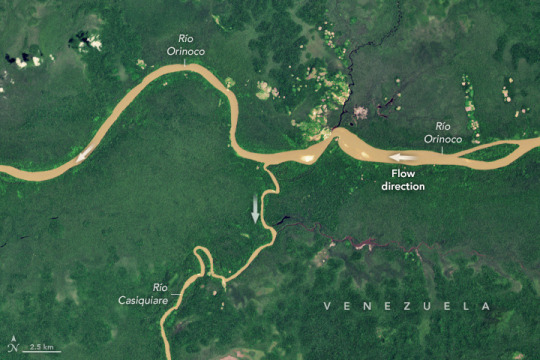
When Rivers Take a Weird Turn
Some rules of hydrology are made to be broken. Two such infractions occur at junctions along rivers in Venezuela and Suriname, where the water flows in unexpected ways.
In Venezuela’s Amazonas state, the Río Casiquiare splits from the Río Orinoco as it flows gently through dense forest. Many rivers branch, or bifurcate, along their routes, and the branches almost always rejoin the main river channel. Not so with the Casiquiare. After veering south, it continues to meander off, flowing hundreds of kilometers until joining the Rio Negro and ultimately the Amazon River in Brazil.
The OLI-2 (Operational Land Imager-2) on Landsat 9 captured this image of the unusual river fork in March 2025. At first glance, one might assume that the Orinoco flows from west to east, with the narrower Casiquiare feeding into it from the south. But the reverse is true, and what appears to be a convergence is really a divergence. Some scientists think the split developed due to a combination of low topographic relief and high flow volume during floods.
This confounding waterway is one of several in the Americas described in a recent paper as seeming to “defy the rules” of hydrology. The Casiquiare, the paper’s authors note, is both a distributary of the Orinoco and a tributary of the Amazon. It represents a natural, navigable passage between the two largest watersheds of South America.
This improbable connector poses a hydrologic conundrum. All water in a drainage basin should, in theory, flow toward larger rivers. But the Casiquiare diverts about one-quarter of the Orinoco’s flow, sending it elsewhere. On hydrologic maps, the boundary between the Amazon and Orinoco basins is shown crossing the Casiquiare. “This violates multiple watershed delineation rules,” the researchers write, “but there is no alternative.”

The Wayombo Rivier (Wayombo River) in Suriname exhibits a similar but slightly different flavor of unexpected behavior. The Boven Wayambo (loosely translated to “upper Wayambo”) splits and becomes the Wayombo—a river that runs over flat terrain and can flow either entirely west or east depending on circumstances, the researchers concluded.
The OLI-2 on Landsat 9 acquired this image (above) of the junction in September 2023. To the west, the Wayombo joins the Nickerie River, and to the east, it meets the Coppename. Both empty into the Atlantic Ocean.
Which way the Wayombo flows depends on natural and human factors, including precipitation and infrastructure. For example, a lock near the junction with the Nickerie helps draw water west to support rice cultivation near that river’s outlet. The Wayombo may otherwise run east toward the Coppename.
The SWOT (Surface Water and Ocean Topography) satellite mission—led by NASA and the Centre National d’Études Spatiales (CNES)—may aid in understanding the hydrological nuances of unusual waterways such as the Casiquiare and the Wayombo, the authors note. Since December 2022, SWOT has been measuring the height of nearly all water on Earth’s surface, developing one of the most detailed, comprehensive views yet of the planet’s ocean and freshwater lakes and rivers.
NASA Earth Observatory images by Wanmei Liang, using Landsat data from the U.S. Geological Survey. Story by Lindsey Doermann.
3 notes
·
View notes
Text
a brand new type of buny has mysteriously popped into existence atop a high and remote tepui in the orinoco basin. it is 3 inches long and its already critically endangered :(
14 notes
·
View notes
Text
(WIP) Rivers of Ehrð
So this has been in the works for several months, and will be likely for several more, but i have been working on a global map showing the river networks of my fictional version of Earth. They are broadly the same as the real world but due to differences in rainfall and climate there are differences. (open for zoomed in images)

There are no endorheic basins, meaning all water eventually reaches the ocean, and global mean sea level is about 20 metres lower.
Anyway, I have just finished mapping and tracing out the basins for every river which is over 1000km long in the real world, as well as some others in areas that are too arid in real life to be true rivers.
Regional Maps
For convenience of reading and because I haven't got names for everything yet, I will use the real life region names. If a river has it's own name in my world I will also use that.
I will list the rivers in a clockwise direction along coastlines, usually starting from the edge of the map. rivers on islands will go after the rest. Green names mean that i have my own name for the river in the fictional world.
Northern North America

Fraser
Kuskokwim
Yukon
Mackenzie
Rest of North America

Misinipi (Churchill)
Nelson
St Lawrence
Mississippi
Brazos
Colorado (Texas)
Grande
Santiago
Colorado (The one with the Grand Canyon)
Columbia
South America

Magdalena
Orinoco
Essequibo
Amaru (Amazon)
São Francisco
Plait/Plate (la Plata)
Europe

Kızıl
Dona (Don)
Dnieper
Dniester
Danube
Tagus
Loire
Rhine
Elbe
Blac/Black (river draining what would be the Baltic Sea)
Northern Dvina
Pexohra (Pechora)
I'm not listing the ones on the island next to Britain, which is named Fairixant
North Africa

Niger
Volta
Gambia
Senegal
Tamanrasset
Hamra (Saguia el-Hamra)
Draa
Chott el Djerid
Sahabi
Nile
Southern and Central Africa

Jubba
Zambezi
Limpopo
Orange
Congo
Ogooué
India and Middle East

Patma (Ganges-Brahmaputra)
Godavari
Krishna
Narmada
Indus
Helmand
Minab
Shatt al-Arab (Arab)
Matti
East and Southeast Asia

Songhua
Huwan (Huang He/Yellow)
Yangtze
Pehrl (Pearl)
Red/Hong
Mekong
Lapaina (Irriwaddy/Salween)
Western Siberia

Corta (Ob)
Onesi (Yenisei)
Eastern Siberia

Khatanga
Lena
Suluma (Kolyma)
Anian (Anadyr)
Amur
Oceania and Borneo

Mamberamo
Sepik
Fly
Murray
Kati Thanda
Flinders
Kapuas
Barito
8 notes
·
View notes
Text
Hello once again! New day, new fish! And what a fish we have today!
Today’s Catch of the Day is the Tambaqui (*colossoma macropomum*), otherwise known as the Black Pacu, Black Finned Pacu, Giant Pacu, Cachama, Gamitama, and sometimes simply Pacu, which is the common name referring to a variety of omnivorous freshwater fish of the *serralsalmid* family, local to South America, which are related to piranha.
The Tambaqui is the second heaviest scaled freshwater fish in South America, after the arapaima, and can reach up to 3.6 ft in length and 97lbs, although you’re more likely to see them at about 2.3 ft long and at about 60 lbs. Their similar shape to piranha has led to many misidentifications of juvenile Tambaqui as their carnivorous cousins; the Tambaqui is tall and narrow, with a large arched back. Their most distinct divergence from piranha can be noted at their teeth, which are flat and molar-like, adapted for crushing seeds and nuts. The lower half of the fish is mostly black, with the front half ranging between a gray, yellowish, or olive hue. Tambaqui sit alone as the only member of the genus *colossoma*, though the members of the *piractus* genus were included in the past.
The Tambaqui is native to the Amazon and the Orinoco River basins, ranging from nutrient rich whitewater rivers such as the Putumayo, to blackwater rivers such as the Rio Negro, to clearwater rivers such as the tributaries of the Madeira. They are commonly kept in aquaculture worldwide.
They are largely solitary animals that spend the 5-7 month duration of the local flooding season in flooded forests, moving out to main river channels and floodplains lakes as the water levels drop. The aforementioned months spent in flooded forests comprise their non-breeding season, while their breeding season begins with the start of the next flood season, between November and February During this time they gather in large numbers and spawn in whitewater rivers along grassy rivers and shores with wood strewn about. Tambaqui are long-living fish, known to live between 40 and 65 years old! Not exactly what you picture when you think of a sexagenarian!
These tremendous fish are listed as Near Threatened by the IUCN Red List, meaning that while they are not in major danger of extinction, we must be mindful and diligent in our stewardship of them and their habitats, especially as the Amazon is continuously harvested and damaged for resources. Please, if possible, do what you can to ensure the longevity and conservation of the Tambaqui and their homes, at the link below and in many other places!
Lastly, of course, the Tambaqui places as a Platinum-tier fish on our fishy rating system!

2 notes
·
View notes
Note
Another really dumb thought, but my first reaction to learning that Tanner sacrificed the Falkry part of him to blend in with humans (which I’m assuming also has to do with the wings getting cut off. Either way, I feel really bad for him and hope he does well/better) was that he’d probably make a really good boxer or something along those lines, assuming dude kept all the other traits (unnaturally strong and magic and all that).
Not sure if that’s somehow offensive or disheartening that that’s my first thought (I really don’t know and, again, overthinky), but I just think it would be kinda funny to just have your seemingly average looking human beat a mountain of a man in arm wrestling without breaking a sweat or something like that. In either case, assuming dude is fine for recreational violence (since I just remembered that most are pacifists or something), he’d be goated (again, if all other traits remain)
Idk, brain thoughts be like that
Hope you have a great day/night and take care of yourself and all that jazz :)
-idk
(Also very cool that you know a lot about nature stuff! Do you have a favorite fact you know?)
Don't worry, it's not offensive at all :)
And he does do better later on in the story. He acts as the "peacekeeper" of the whole ream, the only one holding them together sometimes.
And yes, he does still possess Falkry-level strength (though he does not have magic anymore -- the experiments that took his wings also disrupted his ability to access magic, so he can no longer use it like Shadow can)
Here's one of my favorite nature facts about an exotic bird species I love:
The Joatzin, also known as the reptile bird, skunk bird, or stinkbird, is a species of tropical bird found in swamps and mangroves of the Amazon and the Orinoco basins in South America. It is unique for having chicks that have claws on two of their wing digits which fall off later in life. Like literal feathered dinosaurs. It got the nickname “stinkbird” because of its ability to produce a foul odor when threatened.
You can see the wing-claws on the baby Hoatzin below, as well as what it looks like in adult form (I also included a short video snippet of what the baby looks like climbing with its wing claws)
They TOTALLY look like prehistoric creatures!



youtube
2 notes
·
View notes
Text
Tumblr's Favourite Animal - CONTENDERS (#8)
Continuing with the introductions...
That's a snazzy looking turtle! It's called mata mata (Chelus fimbriata) and it comes from the Amazon river basin and the eastern Guianas. Mata matas were thought to have also lived in the Orinoco basin, but as it turns out, those populations belong to another species. Its shell is reminiscent of a floating piece of bark, and its head resembles a fallen leaf. It lies on the riverbed, breathing through its long snout and using its skin flaps to blend in with its surroundings. When an unsuspecting fish arrives, it ambushes its prey by sucking it in through its wide mouth.
Nominated by @lyzanewe

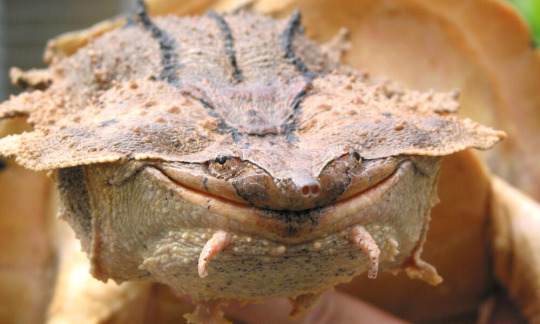
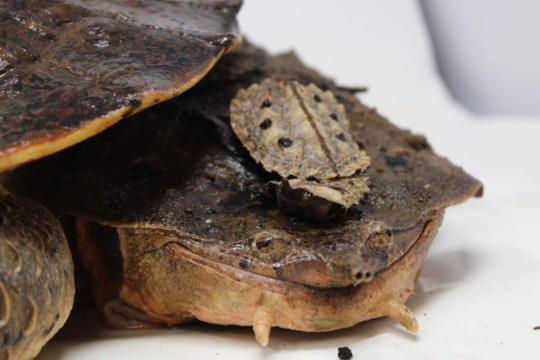
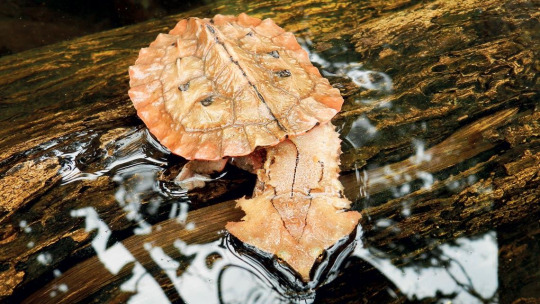
#animals#animal#tournament#tumblr tournament#bracket tournament#tournament poll#tumblr's favourite animal#tumblr's favorite animal#mata mata#matamata#turtle
10 notes
·
View notes
Text
Round 2, Poll 17
Emerald Starling vs Zigzag Heron


sources under cut
Emerald Starling
eBird Sightings - 27
IUCN Status - Least Concern
Location: Africa - South Guinea, North Sierra Leone and Central Ivory Coast
Zigzag Heron
eBird Sightings - 1,416
IUCN Status - Least Concern
Location: South America - Basins of the Orinoco, Negro, and Amazon rivers
"just look at them; they say "ooo""
Images: Starling (Michael Whitlock); Heron (Tim Liguori)
Stats pulled from Birds of the World
31 notes
·
View notes
Text

Hoatzin and chick.
The Hoatzin is a species of tropical bird found in swamps, riparian forests, and mangroves of the Amazon and the Orinoco basins in South America.
4 notes
·
View notes
Photo

The Dartrier or Golden Ears (Senna elata) is a beautiful tree native to the Orinoco basin (Colombia and Venezuela) which has been introduced for ornamental and medicinal purposes in many countries. It has many vernacular names. Its species name, alata, which means "winged" relates to the shape of its fruits which have four wings.
The Epis d'or is a shrub 4 to 8 m high with long candelabra-like stems bearing long yellow-orange spikes. The 2 to 3 m long stems are cylindrical and twisted. On these stems are born leaves 50-80 cm long, consisting of eight to ten pairs of leaflets. These leaflets are oval with a small tip. The flower spikes consist of many small cup-shaped flowers, open at the bottom and closed with a waxy coating at the top. These erect ears measure between 15 and 40 cm in height. The leaves and flowers have a foul smell. The fruit is a straight or slightly curved, very dark brown pod, about 15 cm long, with a kind of wing on each side. The pods contain between 50 to 60 flattened triangular seeds.
11 notes
·
View notes
Note
Pterophyllum scalare, most commonly referred to as angelfish or freshwater angelfish, is the most common species of Pterophyllum kept in captivity. It is native to the Amazon Basin in Peru, Colombia, and Brazil. Particularly to the Ucayali river in Peru, the Oyapock River in French Guiana, the Essequibo River in Guyana, the Solimões, the Amapá, and the Amazon rivers in Brazil. It is found in swamps or flooded grounds where vegetation is dense and the water is either clear or silty. Its native waters range from a neutral pH of 7.0 down to near 6.0, with a general water hardness (gH) range of 3 to 10 °dH, and water temperature ranging from 26 to 30 °C (75 to 86 °F). This is the species of angelfish most frequently found in the aquarium trade. A similar (cross-breeding possible) P. scalare exists in the Rio Orinoco. They are of the same size and shape, the only difference being the stripes; the Orinoco P. scalare has thinner, but dual, stripes.
The diet of Pterophyllum scalare consists of a wide spectrum of prey; they feed on tiny fish fry and younger, juvenile fishes, young and mature shrimps, crabs, prawns, various worms, mosquito larvae, and water bugs. Additionally, they will opportunistically catch any smaller-sized floating insects that have fallen onto the surface of the water.

i love fishies. look at that thing. thats an animal thats alive and exists
3 notes
·
View notes